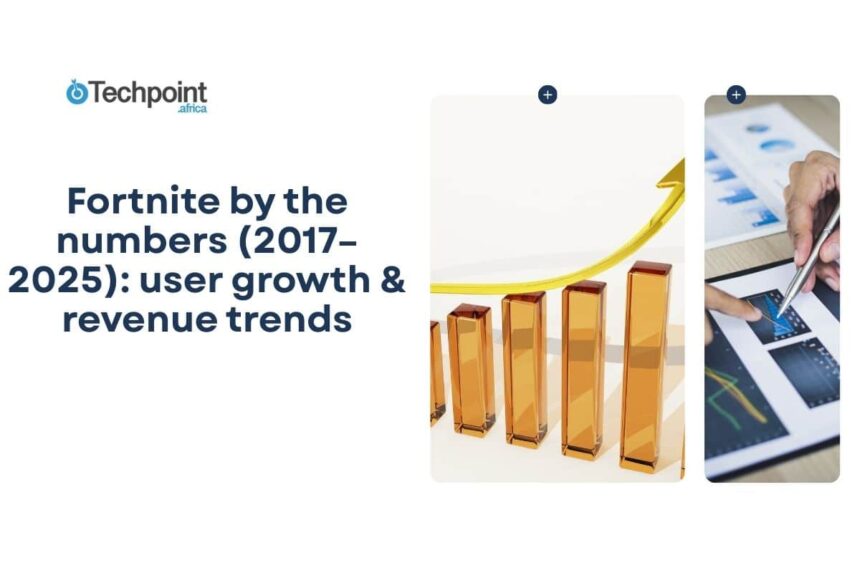Fortnite’s Revenue and Business Model
Now, let’s talk money. Because while the game is free-to-play, Fortnite is far from free to profit off of. Here’s a breakdown of where the money comes from:
Revenue sources
Fortnite’s revenue model is built on a few key pillars:
- Battle Pass: This seasonal subscription service offers players exclusive in-game content, challenges, and rewards for a fixed fee. The Battle Pass is a major driver of revenue, with millions of players opting in each season.
- V-Bucks: This in-game currency can be purchased with real money and used to buy cosmetic items like skins, emotes, and wraps. V-Bucks are a major moneymaker for Fortnite, with players spending hundreds of millions each year on virtual goods.
- Collaborations: Fortnite regularly partners with brands, musicians, and other IP holders to create limited-time events, skins, and items. These collaborations generate buzz, drive engagement, and bring in additional revenue through microtransactions.
- Merchandise: Epic Games also sells physical merchandise like clothing, accessories, and toys related to Fortnite. This diversified revenue stream helps offset the reliance on in-game purchases and keeps the brand relevant beyond the digital realm.
Overall, Fortnite pulls in an average of $5 billion in revenue annually, making it one of the top-grossing games in the world. The game’s business model has proven to be both lucrative and sustainable, with a loyal player base willing to spend on premium content.
Fortnite vs. Competitors
While Fortnite has enjoyed immense success, it’s important to compare it to other battle royale games on the market. Here’s how Fortnite stacks up against its main competitors:
Fortnite vs. PUBG
PlayerUnknown’s Battlegrounds (PUBG) was one of the first battle royale games to gain mainstream popularity, paving the way for titles like Fortnite. While PUBG has a dedicated player base and a strong esports presence, Fortnite has surpassed it in terms of cultural relevance, revenue generation, and player engagement. Fortnite’s vibrant art style, frequent content updates, and innovative events have kept it ahead of PUBG in the battle royale genre.
Fortnite vs. Apex Legends
Apex Legends, developed by Respawn Entertainment, has emerged as a strong contender in the battle royale space since its launch in 2019. While Apex Legends offers a different gameplay experience with its character-based abilities and team mechanics, Fortnite remains the leader in terms of player numbers, revenue, and global reach. Fortnite’s cross-platform compatibility, creative tools, and community features have solidified its position as the top battle royale game in the industry.
Future Trends and Growth Opportunities
Looking ahead to 2026, Fortnite shows no signs of slowing down. Here are some key growth opportunities and trends to watch:
- Unreal Editor for Fortnite (UEFN): Epic Games’ integration of Unreal Engine tools into Fortnite will empower players to create their own custom maps, games, and experiences within the game. This user-generated content will drive engagement, creativity, and community building.
- Creator Economy: Fortnite’s embrace of content creators, streamers, and influencers has been a key driver of its success. The game will continue to support and collaborate with creators, offering new ways for them to monetize their content and engage with their audiences.
- AI-generated maps: As AI technology advances, Fortnite may incorporate procedurally generated maps and environments to keep gameplay fresh and dynamic. These AI-generated elements could enhance replayability and introduce new challenges for players to overcome.
While Fortnite’s future looks bright, there are still challenges to navigate, including player fatigue, legal issues, and competition from emerging titles. By staying innovative, responsive to player feedback, and focused on building a vibrant community, Fortnite is poised to remain a cultural phenomenon for years to come.
As someone who never quite mastered the floss dance or built a sky-high fort in the heat of battle, I may never fully understand the allure of Fortnite. But one thing is clear: this game has transcended its genre, its platform, and even its industry to become a global entertainment powerhouse. And for that, I tip my hat to the serious gamers who made it all possible.
The game had already made a name for itself, with a global player base and a massive following. In that year alone, Fortnite raked in an estimated $3.7 billion in revenue. This was a significant jump from the previous year, showcasing the game’s staying power and continued popularity.
But how exactly does Fortnite make money? The answer lies in its robust monetization strategy. The game offers a variety of in-game purchases, from skins and emotes to battle passes and virtual currency. These microtransactions allow players to customize their gaming experience and stand out on the virtual battlefield.
Additionally, Fortnite has partnerships with brands and hosts sponsored events, further boosting its revenue streams. The game’s cross-platform play and regular updates keep players engaged, ensuring a steady flow of income for Epic Games.
Looking ahead, Fortnite’s revenue projections for 2025 and beyond continue to be impressive. With an estimated $6.01 billion in revenue projected for 2025 and $6.21 billion for 2026, the game shows no signs of slowing down.
In conclusion, Fortnite’s success can be attributed to a combination of factors, including its next-gen console support, cloud gaming accessibility, and continuous updates. With a dedicated player base and a thriving esports scene, Fortnite remains a powerhouse in the gaming industry, setting the bar for interactive entertainment. 34% of Gen Z still call Fortnite their go-to game, even as other competitors rise and fall. They’re the social media generation, and Fortnite’s the social media game.
Millennials (Ages 26–40)
Millennials are the OG Fortnite players. They remember when the game was just a whisper on the wind, and they’ve stuck around for every season, every event, and every meta shift. 26% of Millennials still log in regularly, trading Victory Royales for work-life balance.
Gen X and Boomers (Ages 41+)
Even Gen X and Boomers aren’t immune to Fortnite’s pull. 10% of them have picked up a controller or keyboard to see what all the fuss is about. Some just want to bond with their kids. Others are in it for the nostalgia, reliving their arcade days in a digital world.
Gender breakdown
Fortnite’s come a long way from the “boys only” club. It’s now a game that everyone’s playing, regardless of gender.
54% of Fortnite players are male, while 46% are female. That’s a nearly even split, showing how Fortnite’s appeal transcends traditional gender norms.
Geographic spread
Fortnite’s global. Really global. It’s not just a game; it’s a cultural phenomenon that’s touched every continent (except Antarctica, but who knows what penguins are up to these days).
Here’s the current player distribution:
- North America: 35%
- Europe: 25%
- Asia: 20%
- Australia: 10%
- South America: 7%
- Africa: 3%
It’s a mixed bag, but that’s Fortnite’s charm. No matter where you are, you’re never really alone in the game. Someone’s always building, shooting, or dancing in the lobby.
The future of Fortnite: What’s next?
Fortnite’s not going anywhere. Epic Games has made sure of that by building a game that’s more of a lifestyle than a pastime. And with a roadmap that’s constantly expanding, here’s what’s coming down the pipeline:
More crossovers
Fortnite’s become the ultimate crossover game. From superheroes to musicians to anime icons, the game’s collab list keeps growing. Expect even more wild crossovers in the future, with brands and characters you never thought you’d see in the game.
UGC explosion
Unreal Editor for Fortnite has unlocked a new era of creativity. Players are now building their own experiences, turning Fortnite into a place for games, concerts, and digital art shows. Expect more user-generated content in the future, with Epic Games supporting creators every step of the way.
Live events and concerts
Fortnite’s live events have become legendary. From Travis Scott’s concert to the black hole that ended Chapter 1, these events keep players coming back for more. Expect even bigger and more ambitious live events in the future, with artists and creators pushing the boundaries of what’s possible in a virtual world.
Fortnite isn’t just a game; it’s a global phenomenon. And with revenue numbers that keep climbing, it’s clear that Epic Games has struck gold with their battle royale juggernaut. As long as players keep logging in, building, and battling, Fortnite will continue to dominate the gaming landscape for years to come.
By 2026, we can expect to see a continued dominance of Gen Z players, with the 10-25 age range still making up the majority of Fortnite’s user base. Millennials aged 26-40 will also continue to be active players, with a focus on casual gameplay and late-night squad sessions.
Gender split is likely to remain skewed towards males, with around 90% of Fortnite players being male. This disparity may be influenced by the game’s removal from app stores, where it had a more balanced gender representation.
In terms of geography, the United States will continue to have a significant player base, with other countries like Russia, Brazil, Poland, and Mexico also playing a key role in Fortnite’s global reach. Emerging markets in Southeast Asia, Australia, Africa, and the Middle East may see increased adoption as mobile re-entry and creator tools become more accessible.
Fortnite’s growth will be driven by a combination of major events that spike engagement, marketing strategies that leverage social virality, and unique features like user-generated content, live events, and monetization loops. These elements have set Fortnite apart from its competitors like PUBG and Apex Legends, allowing it to maintain its position as the top battle royale game.
Looking at the global gaming landscape, battle royale games are becoming increasingly popular, especially in countries like China, Vietnam, and India. While casual single-player games still hold the top spot in most regions, battle royale engagement is on the rise worldwide.
Overall, Fortnite’s future looks bright as it continues to evolve and adapt to the changing gaming landscape. With a focus on innovation, community engagement, and cultural crossovers, Fortnite is expected to remain a powerhouse in the gaming industry for years to come.
Fortnite has been a dominant force in the gaming industry since its launch in 2017, attracting millions of players and generating billions in revenue. However, as the gaming landscape continues to evolve, new waves of innovation and audience engagement are set to keep Fortnite relevant well beyond 2025.
Growth projections suggest that while user growth may slow, it will stabilize with the introduction of Creative 2.0 and AI-generated maps that empower players and creators to shape their own experiences like never before. Revenue is also expected to maintain steady upward momentum, driven by diversified streams such as esports tournaments, Web3-powered skins and collectibles, and collaborations with top YouTubers and streamers featuring AI avatars.
Emerging opportunities for Fortnite include expanding into esports with rising prize pools and viewership, integrating Web3 and AI technologies for limited-edition skins and personalized content, and venturing into media projects such as animated series and metaverse-style social hubs.
Despite these opportunities, challenges loom on the horizon. Player fatigue, legal battles with app stores, and concerns over monetization strategies may impact Fortnite’s future success. However, by staying ahead of the curve and embracing sustainable evolution, Fortnite is poised to remain a key player in the gaming industry well into 2026.
In conclusion, Fortnite’s success is a testament to its innovative approach and strategic vision. By constantly evolving with its community, embracing creativity, and prioritizing engagement, Fortnite has become a cultural phenomenon. Marketers and developers can learn valuable lessons from Epic Games’ playbook, including the importance of building immersive experiences, nurturing creator ecosystems, and staying attuned to cultural trends.
As Fortnite continues to shape the gaming landscape, its growth projections for 2026 are promising. With new opportunities in AI-generated content, esports, and media ventures, Fortnite is well-positioned to remain a powerhouse in the industry. Marketers and developers can leverage Fortnite’s data to inform their strategies and drive innovation in their own projects.
Disclaimer: The information provided in this article is based on our independent evaluation and is subjective. We do not guarantee the accuracy or completeness of the content and disclaim responsibility for any errors or omissions. Readers are advised to conduct their research and consult professionals where necessary. the perspective of a student who has just returned to in-person classes after a year of remote learning:
After a long year of staring at my computer screen and attending virtual classes from the comfort of my own home, I have finally returned to in-person classes. The transition back to the physical classroom has been both exciting and nerve-wracking.
One of the first things I noticed upon returning to campus was the bustling energy that filled the hallways. It was refreshing to see my classmates and teachers face-to-face after so much time spent communicating through a screen. The sense of community that comes with being physically present in the same space as my peers is something that I had dearly missed.
However, returning to in-person classes has also come with its challenges. I had grown accustomed to the flexibility and convenience of online learning, but now I find myself having to adjust to a more rigid schedule and the demands of commuting to campus. Additionally, being back in a physical classroom comes with a whole new set of distractions that I had not encountered while learning from home.
Despite these challenges, I am grateful for the opportunity to once again engage in hands-on learning and participate in discussions with my classmates. There is something special about the dynamic interactions that can only be achieved in a face-to-face setting.
As I navigate this transition back to in-person classes, I am reminded of the importance of adaptability and resilience. While the past year has been filled with uncertainty and change, I am grateful for the opportunity to continue my education in a more traditional setting.
Overall, returning to in-person classes has been a mixed bag of emotions, but I am hopeful that this new chapter will bring with it new opportunities for growth and learning. Today, we are seeing a shift in the way people approach their health and wellness. With an increasing focus on preventative care and holistic approaches, individuals are taking charge of their well-being in new and innovative ways.
One trend that is gaining popularity is the use of alternative therapies such as acupuncture, meditation, and herbal remedies. These practices, which have been used for centuries in traditional medicine, are now being embraced by mainstream society as viable options for improving overall health.
Acupuncture, for example, is a form of traditional Chinese medicine that involves inserting thin needles into specific points on the body to promote healing and relieve pain. Studies have shown that acupuncture can be effective in treating a variety of conditions, including chronic pain, anxiety, and insomnia.
Meditation is another practice that is becoming increasingly popular for its ability to reduce stress and improve mental clarity. By taking time to quiet the mind and focus on the present moment, individuals can experience a sense of calm and relaxation that can have lasting benefits on their overall well-being.
Herbal remedies, such as teas, tinctures, and supplements, are also gaining popularity as natural alternatives to traditional medications. Many herbs have been used for centuries for their medicinal properties, and modern research is beginning to validate their effectiveness in treating a variety of ailments.
Overall, the shift towards alternative therapies reflects a growing awareness of the mind-body connection and the importance of treating the whole person, rather than just the symptoms of a disease. By incorporating these practices into their daily routines, individuals can take a proactive approach to their health and wellness and experience the benefits of a more holistic approach to healing.








